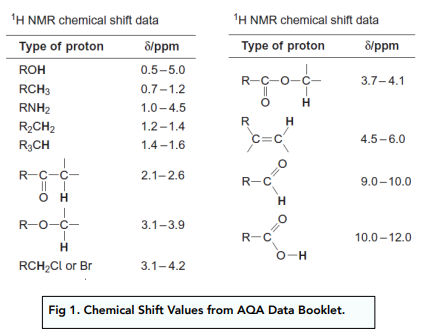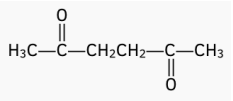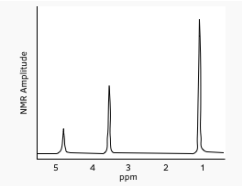Analytical Techniques - Types of NMR: Hydrogen (A-Level Chemistry)
Types of NMR: Hydrogen
Proton (¹H) NMR Spectroscopy
¹H NMR investigates the hydrogen atoms in a molecule.
As there are a large number of hydrogen atoms in almost all organic molecules, this type of spectroscopy is particularly useful.
There are two different types of ¹H NMR: low resolution (studied in detail in this chapter) and high resolution ¹H NMR (looked at in the next chapter).
Low Resolution ¹H NMR
When interpreting low resolution ¹H NMR spectra you have to look at both:
- Number of peaks – the number of peaks is equivalent to the number of hydrogen atoms in different environments
- Relative area under peaks – the relative area under each peak indicates the relative number or ratio of H atoms in each environment. This is known as the integration number.
Standards
The same standard, TMS, is used for ¹H NMR as it is for ¹³C NMR for the same reasons outlined in chapter 198. It is given chemical shift value of 0.
Interpreting Low Resolution ¹H NMR Spectra
The data you will be given for ¹H NMR chemical shifts is given below.

Worked example: Identify the number of peaks produced by this molecule in a ¹H NMR spectrum. Identify the integration factor produced by the peaks.

Answer: 2 peaks
The relative ratio of the peaks will be 2:3 = integration factor.
Explanation: The hydrogen atoms in the two CH₃ parts of the molecule are attached to C=O bonds which in turn are attached to -CH₂.
This represents one chemical environment and will produce one peak with a relative area underneath of 3, as there are 6 H atoms.
The hydrogen atoms in the -CH₂ parts of the molecule are attached to another CH₂ part and a C=O on the other sides.
This represents the second chemical environment which will produce one peak with a relative area of 2, as there are 4 H atoms.
Worked example: Identify the molecule which gives this spectrum using low resolution ¹H NMR. It only contains C, H and O. Use the data booklet to help you.

Answer: CH₃CH₂OH
Explanation:
The peak closest to 0 has a peak at between 0.7 and 1.2 and an integration factor of 3, so it is likely to have 3 H atoms.
It is likely to be R-CH₃
The next peak is between 3.1 and 3.9 and an integration factor of 2, so it is likely to have 2 H atoms.
It is likely to be R-O-CH₂

The final peak is between 0.5 and 5 with an integration factor of 1, so it has 1 H atom.
It is likely to be R-OH.
The molecule is ethanol:






Still got a question? Leave a comment
Leave a comment